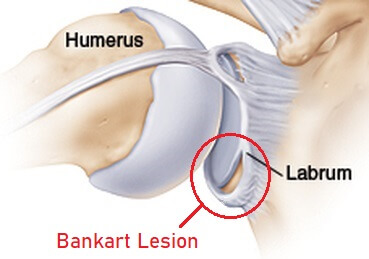- Home
- Bankarts Tear
Bankarts Tear
Bankart Tear
The shoulder is a ball and socket joint. It is one of the most complex joints in the human body. In a healthy shoulder joint, the ball, or humeral head, and socket, or glenoid, remain stable, while allowing maximal range of motion of function. Reinforcing this stability if the joint is the glenoid labrum, a fibrocartilaginous rim that encircles the edge of the glenoid, making its concavity deeper, and therefore more stable. Additional ligaments surrounding the joint (some of which are attached to the glenoid labrum), help to hold the humeral head inside its socket. Together, these bones and tissue keep your shoulder in place and stable through a wide range of motion.

What Is A Bankart Lesion
Sometimes, injury or overuse can result in forceful dislocation or subluxation that tears the cartilage and ligaments of the shoulder. In dislocation, the humeral head comes away from the glenoid, therefore stretching and possibly tearing the surrounding soft tissues.
The most common type of shoulder dislocation is anterior. This most commonly occurs when the arm is abducted away from the body, and forced forward or downward in an injury. When the humeral head dislocates anteriorly, the ball forcefully pushes against the anterior glenoid labrum at the front of the socket. A glenoid labrum tear in the anterior joint is called a Bankart lesion. When the labrum is torn, the shoulder joint is less stable, and allows the humeral head to move around more than normal. Posterior dislocation (when the arm is forced backwards) can also lead to a tear in the labrum, though less commonly. If your tear is accompanied by a fracture in the bone of the shoulder socket (glenoid), this is called a bony, or osseous, Bankart lesion. An untreated Bankart lesion can lead to chronic shoulder instability — meaning your shoulder may dislocate again in the future, probably in situations involving less force than the original injury.
BOOK AN APPOINTMENT
First Choice for Orthopedics &
Joint Replacements
CAUSES OF BANKART LESIONS
Bankart lesions are frequently the results of high energy trauma and sports injuries (either acute injuries or overuse injuries from repetitive arm motions). Though anyone can sustain this injury, young people in their twenties are most susceptible.
Possible causes of shoulder dislocations and lesions:
- Car accidents. A sudden blow to the shoulder can knock the ball from its socket, tearing the labrum.
- Sports collisions. Crashing into another person with speed and force — for example, during a football or hockey tackle — can shove the shoulder out of alignment or drag the arm forward or backward, leading to dislocations.
- Falls from sports. Falling and landing on one’s shoulder can lead to shoulder dislocations in athletes, especially in sports where falling with height or speed is common, like gymnastics, skating, rollerblading, or skiing. Sliding into bases during softball or baseball can also harm the shoulder.
- Falls not from sports. Falling off a ladder or tripping on a crack in the sidewalk can deliver enough force to dislocate the shoulder.
- Overuse injuries. In some athletes, overuse of the shoulder can lead to loose ligaments and instability. Swimmers, tennis players, volleyball players, baseball pitchers, gymnasts, and weight lifters are prone to this problem. In addition, non-athletes may develop instability from repeated overhead motions of the arm (for example, swinging a hammer).
- Loose ligaments. Some people have a genetic predisposition to loose ligaments throughout the body (e.g., double-jointed individuals). They may find that their shoulders pop out of alignment easily. Treatment for these patients is often more complex.
SIGNS AND SYMPTOMS OF A BANKART LESION
This type of labrum tear shares many symptoms with other shoulder injuries. A thorough doctor’s exam is necessary to properly diagnose your symptoms.
Symptoms of a Bankart lesion can include:
- Pain. When reaching overhead, at night, or with daily activities. Pain that does not improve with rest, change in activity, OTC medications, or ice, warrants consultation with your healthcare provider.
- Instability and weakness. The shoulder may feel ‘loose’. Patient’s may report apprehension about moving the shoulder into certain positions away from the body. Patients may also report recurrent instability, subluxation, or dislocation with low energy movements, like rolling over in bed, or putting on a seat belt.
- Limited range of motion.
- Mechanical symptoms. Grinding, catching (not moving fluidly), locking in place, or popping can all be symptoms of torn tissue getting caught in the joint.


